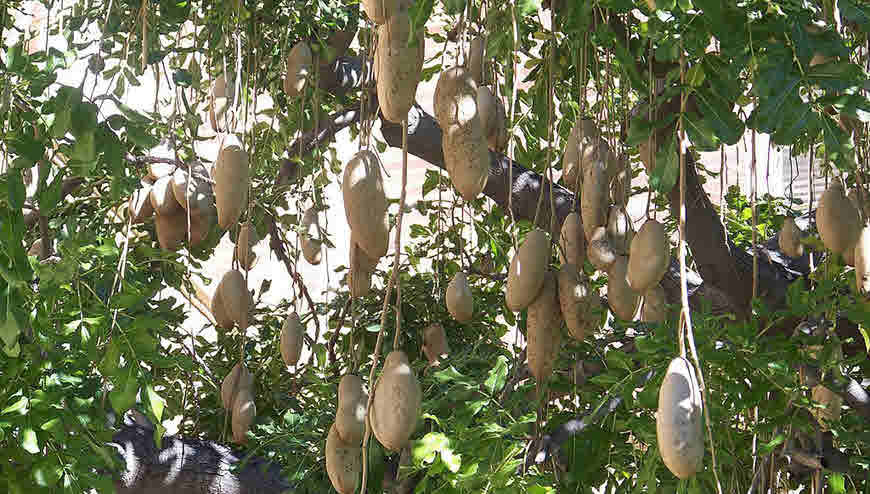Kigelia is flowering tree native to West Africa. It is found throughout tropical Africa, South Africa, Central and West Africa. It is also known as cucumber or sausage tree because of its big fruits (average 0.6 m in length and 4 kg in weight) that has shape of cucumbers. These fruits hangs from long fibrous stalks. It has big maroon, red flowers with yellowish outside color. It is also grown all over India and found abundantly in West Bengal. It can be seen as an ornamental and roadside tree in Delhi, West Bengal and Southern India. In Hindi its common name is Balam Kheera (Kheera is cucumber in Hindi) and Jhar Phanus.

In traditional medicine the various parts of the tree are used for medicinal purpose. Kigelia is used in the treatment of the kidney stones, skin diseases, dysentery, parasitic infestation, post-partum bleeding, diabetes, pneumonia, toothache, rheumatism, CNS depression, worm infestation, genital infections, etc.
A lab study was done on male rats (as the urinary system of male rats is similar to that of humans) with induced urolithiasis (urinary stones located anywhere in the urinary system). The rats were given treatment of ethanolic extract of Kigelia pinnata fruit for 15 days in dosage of doses 200mg and 400 mg/kg/day. The treatment result showed significant reduced kidney stone and also prevented the growth of the urinary stones. Thus the study supported the traditional use of Kigelia for the treatment of the kidney stone.
General Information
- Botanical name: Kigelia pinnata (Jacq.) DC.
- Synonym: Kigelia africana (Lam.) Benth.
- Family: Bignoniaceae
- Botanical name: Kigelia pinnata (Jacq.) DC.
- Synonym: Kigelia africana (Lam.) Benth.
- Family: Bignoniaceae
Vernacular names:
- English name: Common Sausage tree
- Hindi: Balam kheera, Jhar Phanus
- Kannada: Aanethoradu Kaayi, Mara Sowthae
- Telugu: Enuga thondamu, Kijili, Naagamalle
Description
Height of the tree about 10-20 meters; odd pinnately, composite opposite leaves; leaflets are ovate to oblong in shape and 4-18 cm long; Flowering time in spring; Ancillary panicles up to 2 m long; Fused petal corolla; Flowers irregularly bell shaped, 9-13 cm long two lipped, yellowish on outside and purple on inside; Fruits oblong, hard 30-50 cm long, hanging on stalk for several month;
Scientifically Proven Pharmacological Activities
- Antiurolithic activity (Fruits)
- Antioxidant activities
- Anticancer activities
- Antibacterial and Antifungal activities (Roots, Fruits, Bark)
- Anti-inflammatory effects (Fruits)
- Anti-malarial (root bark)
- Central nervous system (CNS) stimulant effect (stem bark extract)
- Antiprotozoal Effect (stem bark and root bark extracts)
- Antidiarrheal (leaf extract)
Traditional Medicinal Uses
In folk medicine the roots, bark, leaves, stems, and fruits are used to treat digestive disorders; roots bark and ripe or unripe fruits are taken as a laxative. The various part of the tree are used internally as well as externally. In some parts of Africa, the fruits of Sausage tree are roasted and eaten. The fruits are also grinded and applied on the face to get blemish free skin and remove sun marks. These are also used by traditional healers, to dress ulcers. The root/bark decoction is prepared and used as gargle to get relief from toothache and for external application on ulcers, and pneumonia. The unripe fruits are used for dressing wounds and also applied on haemorrhoids and rheumatism.